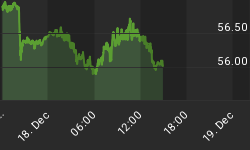While Monday's ISM Manufacturing Index came in near expectations, it was the highest reading since May 2010. Production showed healthy gains moving from 55 to 60.7. New orders also gained 4.3 points moving to a bullish 60.9. Eleven of the eighteen industries reported growth. According to the ISM, December's index level historically has been associated with real GDP growth of 5.0%.
This morning's Wall Street Journal summed up Monday's trading this way:
Fueling the gains were reports that factory activity ratcheted up world-wide, with the U.S., Europe's major economies, Brazil and South Korea posting their best numbers in more than six months. Stocks in those markets all surged, while commodities raced higher on the accelerating global economic recovery. Copper reached a fresh all-time high.
With some positive fundamentals in the hopper, it is a good time to look at where stocks may be headed. In the U.S. on Monday, the S&P 500 futures closed above 1,256, making the 1,270 to 1,272 range the next short-term hurdle for stocks. The charts below help us determine reasonable upside targets given the current fundamental and technical state of the markets. The timing, in terms of when stocks might reach the next set of probable targets, is uncertain. The market could experience a corrective period prior to reaching 1,313 or 1,326. It may not hit 1,326 for several months, but the odds are good it will hit 1,326 sometime in the next six to nine months.
The weekly chart below identifies possible areas where both short-term buyers (support) and short-term sellers (resistance) may become interested. These are not full-year 2011 targets; they represent the next logical milestones for stocks given what we know today. Stocks could exceed these levels later in 2011.

The monthly chart below takes more noise out of the equation in the form of day-to-day volatility. The chart contains two parallel trend channels (A & B) that may influence the decisions of buyers and sellers later in 2011. It is probable sometime in 2011, possibly after some consolidation or corrective activity; the S&P 500 will fill the white space noted in the chart below. We cover similar concepts in our 2011 Stock Market Outlook, which was released in December 2010.

The CCM Bull Market Sustainability Index (BMSI) closed Monday at 3,745, which from a historical perspective gives us a favorable risk-reward profile for stocks over the next two to twelve months (see table below). The term risk-reward speaks to the probabilistic nature of technical analysis and our market models.

The CCM 80-20 Correction Index (80-20) is not flashing red at the moment. However, the 80-20 Index has entered the yellow zone telling us we need to be ready for some corrective activity sometime in the not-too-distant future.
For readers who are understandably concerned about the elevated levels of bullish sentiment, this sentiment study is worth a scan. The current bull/bear ratio is 2.78 (the study was done at a ratio of 2.77).















